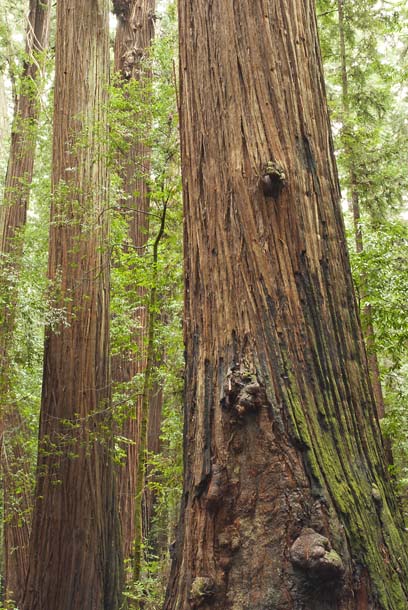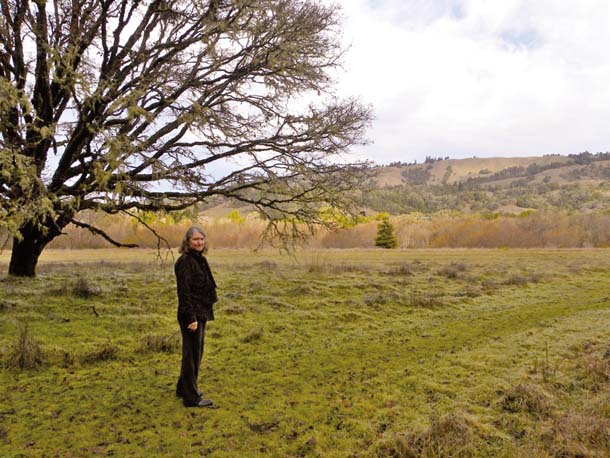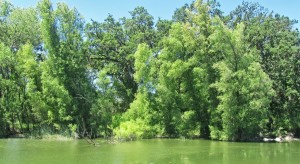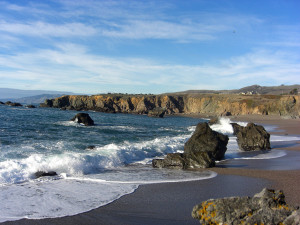Born in Brooklyn and raised in Minneapolis, Kathy Bailey moved to Northern California’s Anderson Valley in 1971 “to live a peaceful life in the country.” Working as a tree planter at first (“a hippie for sure”), she fell in love with this rural community in Mendocino County. Though only a three-hour drive from San Francisco, it seemed a world apart.
Today, Bailey is married to a retired judge, the mother of two children, and a leader of this 3,200-person community’s effort to keep open its only state park, Hendy Woods. And her life has been far from peaceful since that Friday the 13th in May when she found out the park was on the closure list. “It was like a random drive-by for the community,” she says.
Hendy is a small park with big trees–1,000-year-old redwoods. At only 845 acres, it’s not a place to see how far you can hike in a day. But minutes from a sunny parking area, you can be gazing up at several 300-foot-tall, shaggy-barked giants. “It’s awe-inspiring to look up at those trees,” says Bill Boger, owner of Jack’s Valley Store, the last outpost of civilization before the turnoff to Hendy Woods. “It’s a magical place,” says Donna Pierson-Pugh, principal at Anderson Valley Elementary School, where visits to the park are a part of the first-, third-, and fifth-grade curricula.
Hendy Woods is also a mainstay of the valley’s increasingly tourism-based economy. “Our customers make the park part of their routines,” says Deborah Cahn-Bennett, an owner of Navarro Vineyards. “It would be very upsetting if it closed.” The park’s 92 campsites and four cabins provide low-cost lodging for people who want to sip the wine, drink the beer, and eat the apples, persimmons, and other fresh foods that are the valley’s signature products. And it’s almost the only place in the area where visitors can take a stroll in nature on public land. “If Hendy Woods closed,” Bailey says, “I’d have to tell them to take a walk along the highway.”

- Assemblyman Jared Huffman (D-San Rafael) meets with local supporters of the park to discuss how to keep Hendy Woods open. Photo by Kathy Bailey.
The 25-year effort to win initial protection for Hendy’s ancient trees was led by a local women’s group, the Anderson Valley Unity Club, and culminated with the dedication of the park by Governor Pat Brown’s administration in 1963. Between 1979 and 1988, over 200 acres were added to the park, thanks to the efforts of Save the Redwoods League. More recently, though, Hendy Woods seemed to take care of itself while providing local residents with a place to recreate and a steady stream of visitors. Then came the “drive-by,” ironically initiated by the administration of Pat Brown’s son, current Governor Jerry Brown.
Bailey and others countered the proposed closure with an economic argument. Speaking for the Mendocino County Board of Supervisors and the Anderson Valley Chamber of Commerce at a November 1 legislative hearing in Sacramento, she explained that closing eight of the county’s 17 state parks, as proposed, would surely shrink the county’s contribution to state sales taxes and increase its demand for state programs that help the poor and unemployed. “Does doing great harm to most of our businesses by closing Hendy Woods State Park really help the general fund?” Bailey asked in her testimony. “It seems unlikely to us.”
In early November Anderson Valley residents staged a three-day “Occupy Hendy Woods” rally in the park. About 150 people showed up for camping, community meals, teach-ins, and a “day of the dead parks” parade. Bailey attended and got talking with others about how to keep the park open.

- Some of Hendy’s 1,000-year-old redwoods are over 300 feet tall. Photo by Dan Suzio.
In December, the grassroots effort entered a new phase. At a meeting in the Anderson Valley Grange, about a hundred people said they’d be willing to contribute either money or time to keep the park open. Soon after, a core group of 17 people, including Bailey, filed for nonprofit status as Hendy Woods Community, Inc., and submitted a proposal to the state.
The group’s members planned to raise money for the park’s full-time ranger and maintenance positions, while filling three part-time positions with community volunteers. They hoped that those volunteers, combined with additional fundraising and revenue enhancements (including collecting the $8 day-use fee at the gate more assiduously), could close the gap between the park’s $240,000 in annual revenues and its expenses. Only one problem: They couldn’t get a firm number on expenses. Based on spreadsheets from the state, Bailey first estimated a gap of between $70,000 and $150,000. In January the state said, no, the number was actually $200,000. By February it had zoomed up to $270,000, for what the state was calling “ideal service levels,” though Hendy Woods has not been providing ideal service levels for years.
At press time in March, with the July 1 closure date fast approaching, Bailey had a Post-It with the words “moving target” on her computer. But she was optimistic about the prospects of keeping the park open. She had received offers of help from other nonprofits. The county sheriff had promised to assist with law enforcement. The parks department was going to be holding workshops for potential partners soon. And she was now viewing potential concessionaires, who once seemed to be a threat, as a tool to perhaps run part of the park and help fill the revenue gap, whatever it was. “Supposedly the parks department is going to accept proposals from credible nonprofit organizations,” she said. “We’ll see if that includes us.”
The Cost of Closing Parks
California had a $10 billion budget deficit in 2011-2012, and many programs were slashed, including education, health, and human services. So why shouldn’t the state Department of Parks and Recreation be asked to share the pain?
It’s a fair question. But the answer is complicated by the argument that the parks generate economic activity and hence increase sales tax revenue for the state. “State parks generate hundreds of millions of dollars for local economies, and a healthy stream of sales tax revenue,” state Assembly member Jared Huffman (D-San Rafael) said at a November hearing on the impact of park closures. “So before we venture further down this road, we should make sure that the closure plan will produce meaningful savings.”
At the same hearing, Patrick Tierney, a professor of recreation studies at San Francisco State University, stated, “California state parks have a positive return on investment. You are losing money by closing state parks.” His claim is backed up by a 2010 study commissioned by the parks department, which found that state parks generate more than $6 billion in economic activity annually, including $289 million in user fees and sales taxes that go to the state. Likewise, local governments are enriched by park-related revenues of almost $145 million a year.
To minimize the economic hit to local communities and the parks department’s own coffers, the closure list included many parks whose gate revenues are low. But gate revenues are deceiving. Some parks don’t collect fees, and even if they do, many visitors avoid them by parking outside the gates or sneaking in a “free” entrance. The upshot: Many parks on the list have generated significant revenue for local businesses.
Rural communities like the Anderson Valley, in which Hendy Woods State Park is one of the main tourist attractions, would be hurt the most. Yet such communities often have fewer people and less money to help keep their parks open.
As to those vanishing sale tax revenues, “there were some things we were not able to grasp,” admitted Deputy State Parks Director Bill Herms at the legislative hearing. “Tax revenues are not tracked for us to see. Even if they were, they are not returned to us.”

.jpg)




